人教版英语九年级unit5What are the shirts made of?新目标全单元教案(表格式)
文档属性
| 名称 | 人教版英语九年级unit5What are the shirts made of?新目标全单元教案(表格式) | 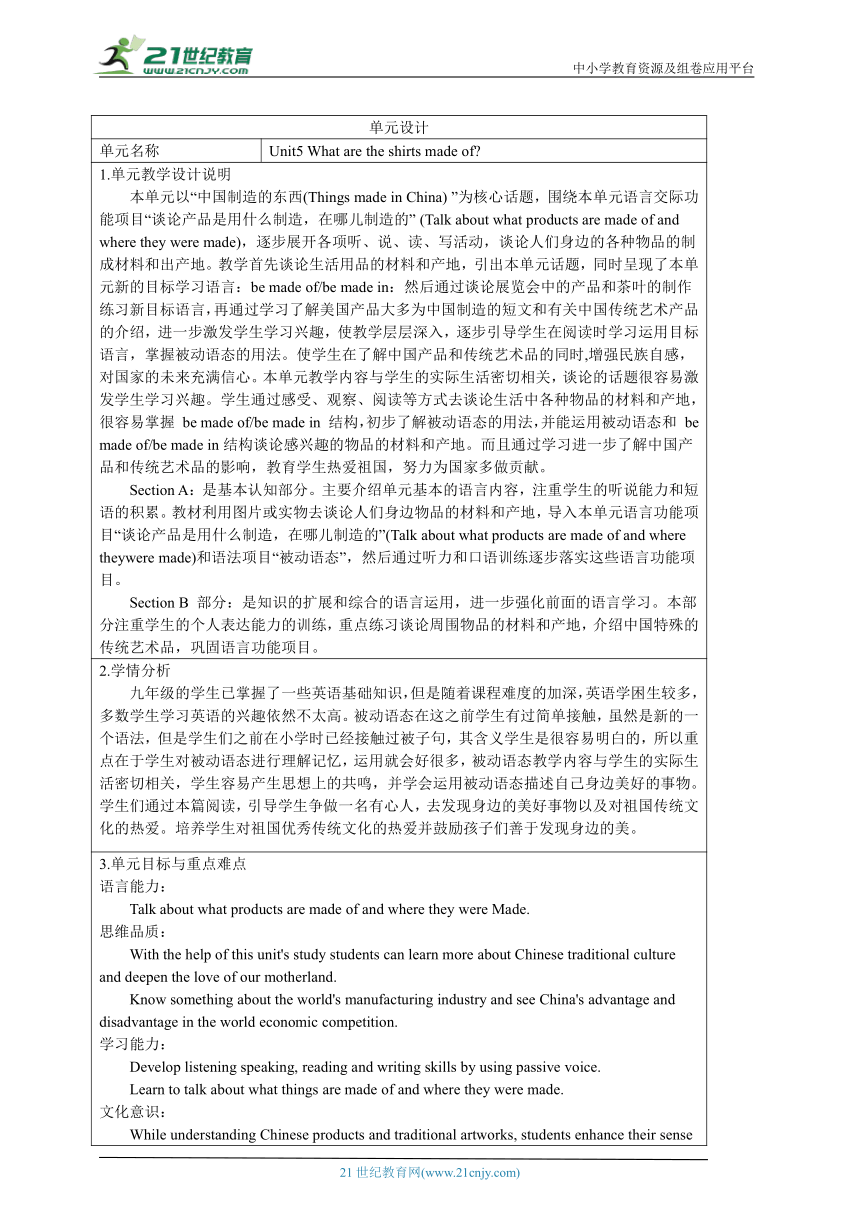 | |
| 格式 | docx | ||
| 文件大小 | 897.5KB | ||
| 资源类型 | 试卷 | ||
| 版本资源 | 人教新目标(Go for it)版 | ||
| 科目 | 英语 | ||
| 更新时间 | 2022-09-03 16:19:46 | ||
图片预览

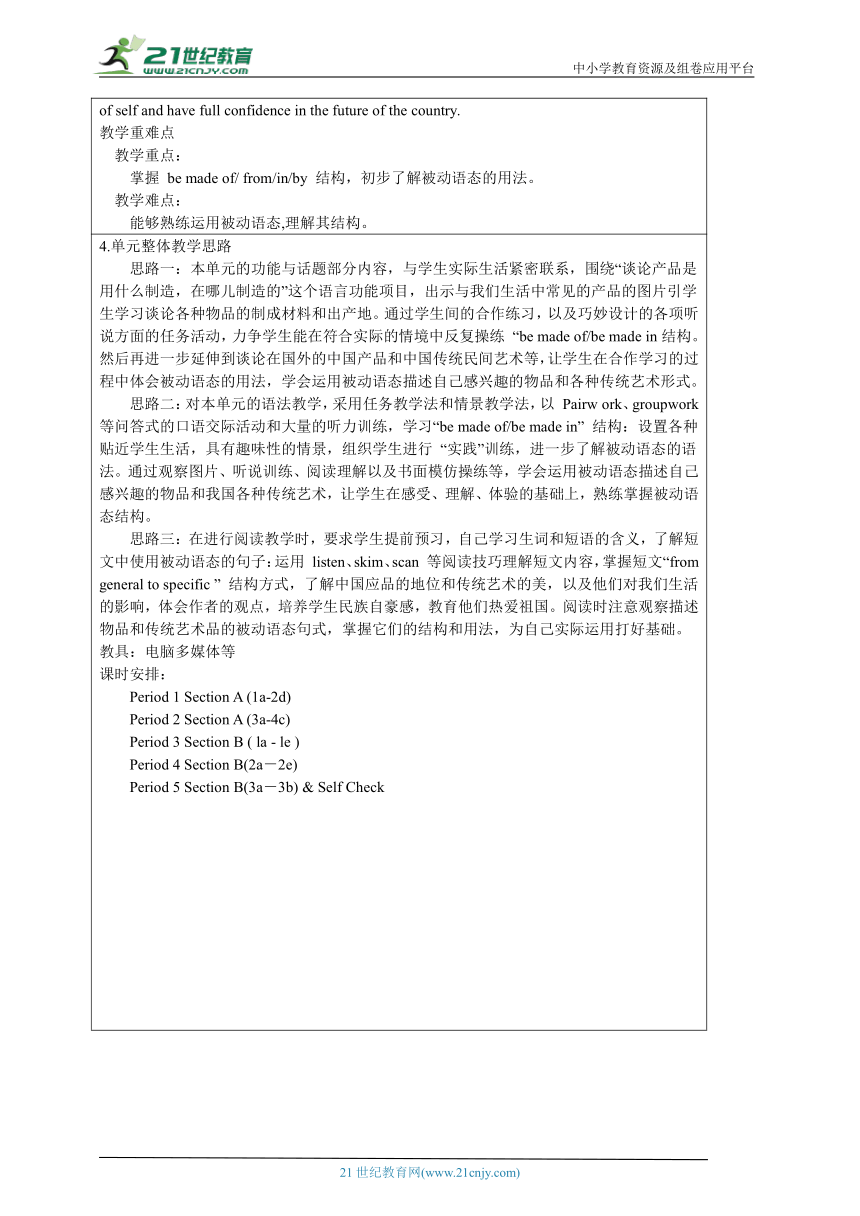
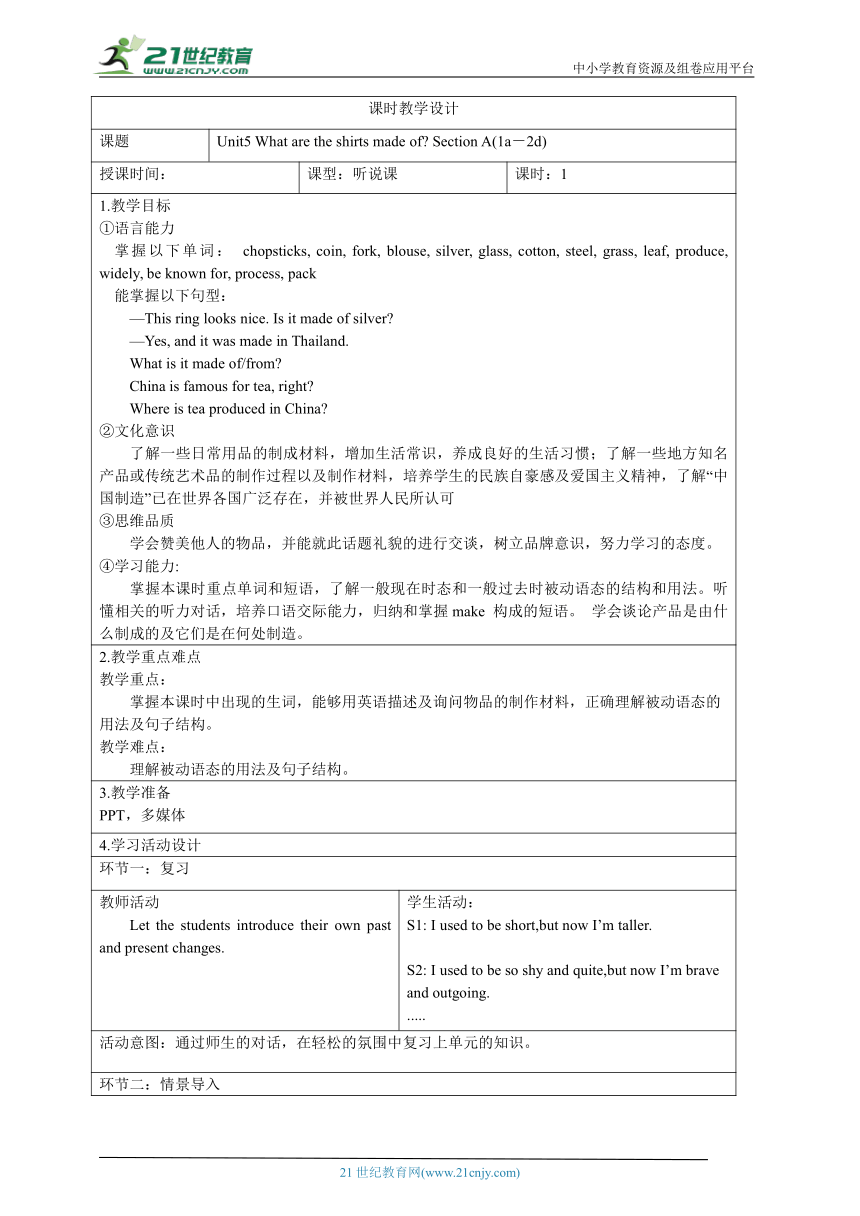
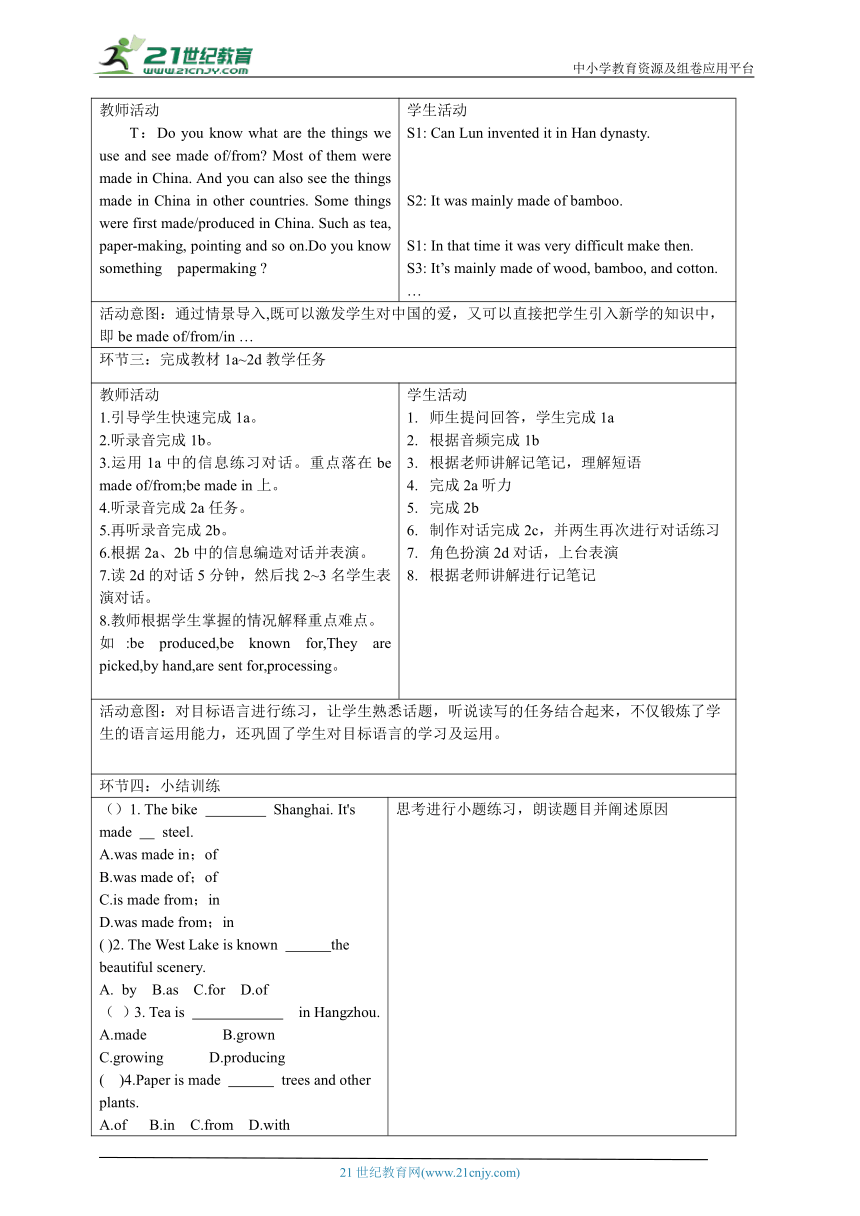
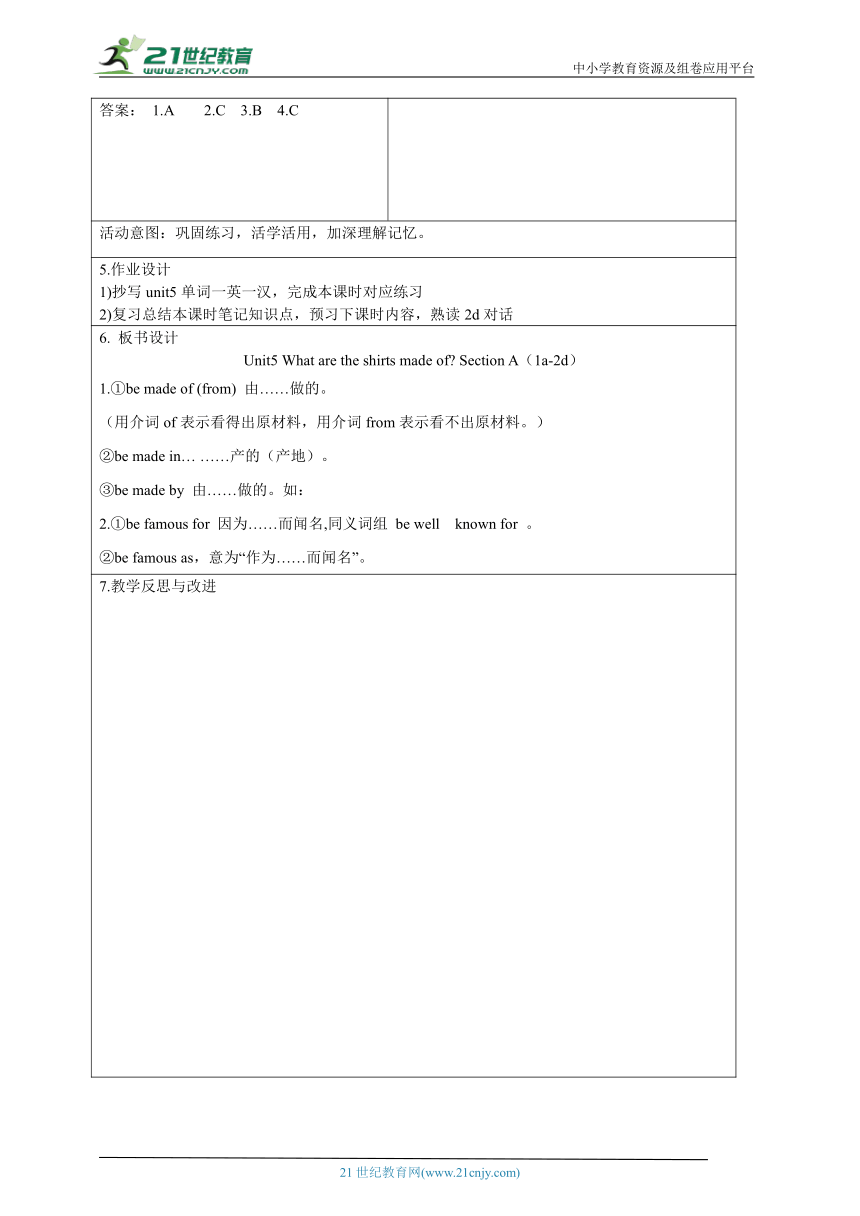
文档简介
中小学教育资源及组卷应用平台
单元设计
单元名称 Unit5 What are the shirts made of
1.单元教学设计说明 本单元以“中国制造的东西(Things made in China) ”为核心话题,围绕本单元语言交际功能项目“谈论产品是用什么制造,在哪儿制造的” (Talk about what products are made of and where they were made),逐步展开各项听、说、读、写活动,谈论人们身边的各种物品的制成材料和出产地。教学首先谈论生活用品的材料和产地,引出本单元话题,同时呈现了本单元新的目标学习语言:be made of/be made in:然后通过谈论展览会中的产品和茶叶的制作练习新目标语言,再通过学习了解美国产品大多为中国制造的短文和有关中国传统艺术产品的介绍,进一步激发学生学习兴趣,使教学层层深入,逐步引导学生在阅读时学习运用目标 语言,掌握被动语态的用法。使学生在了解中国产品和传统艺术品的同时,增强民族自感,对国家的未来充满信心。本单元教学内容与学生的实际生活密切相关,谈论的话题很容易激发学生学习兴趣。学生通过感受、观察、阅读等方式去谈论生活中各种物品的材料和产地,很容易掌握 be made of/be made in 结构,初步了解被动语态的用法,并能运用被动语态和 be made of/be made in结构谈论感兴趣的物品的材料和产地。而且通过学习进一步了解中国产品和传统艺术品的影响,教育学生热爱祖国,努力为国家多做贡献。 Section A:是基本认知部分。主要介绍单元基本的语言内容,注重学生的听说能力和短语的积累。教材利用图片或实物去谈论人们身边物品的材料和产地,导入本单元语言功能项目“谈论产品是用什么制造,在哪儿制造的”(Talk about what products are made of and where theywere made)和语法项目“被动语态”,然后通过听力和口语训练逐步落实这些语言功能项目。 Section B 部分:是知识的扩展和综合的语言运用,进一步强化前面的语言学习。本部 分注重学生的个人表达能力的训练,重点练习谈论周围物品的材料和产地,介绍中国特殊的 传统艺术品,巩固语言功能项目。
2.学情分析 九年级的学生已掌握了一些英语基础知识,但是随着课程难度的加深,英语学困生较多,多数学生学习英语的兴趣依然不太高。被动语态在这之前学生有过简单接触,虽然是新的一个语法,但是学生们之前在小学时已经接触过被子句,其含义学生是很容易明白的,所以重点在于学生对被动语态进行理解记忆,运用就会好很多,被动语态教学内容与学生的实际生活密切相关,学生容易产生思想上的共鸣,并学会运用被动语态描述自己身边美好的事物。学生们通过本篇阅读,引导学生争做一名有心人,去发现身边的美好事物以及对祖国传统文化的热爱。培养学生对祖国优秀传统文化的热爱并鼓励孩子们善于发现身边的美。
3.单元目标与重点难点 语言能力: Talk about what products are made of and where they were Made. 思维品质: With the help of this unit's study students can learn more about Chinese traditional culture and deepen the love of our motherland. Know something about the world's manufacturing industry and see China's advantage and disadvantage in the world economic competition. 学习能力: Develop listening speaking, reading and writing skills by using passive voice. Learn to talk about what things are made of and where they were made. 文化意识: While understanding Chinese products and traditional artworks, students enhance their sense of self and have full confidence in the future of the country. 教学重难点 教学重点: 掌握 be made of/ from/in/by 结构,初步了解被动语态的用法。 教学难点: 能够熟练运用被动语态,理解其结构。
4.单元整体教学思路 思路一:本单元的功能与话题部分内容,与学生实际生活紧密联系,围绕“谈论产品是用什么制造,在哪儿制造的”这个语言功能项目,出示与我们生活中常见的产品的图片引学生学习谈论各种物品的制成材料和出产地。通过学生间的合作练习,以及巧妙设计的各项听说方面的任务活动,力争学生能在符合实际的情境中反复操练 “be made of/be made in结构。然后再进一步延伸到谈论在国外的中国产品和中国传统民间艺术等,让学生在合作学习的过程中体会被动语态的用法,学会运用被动语态描述自己感兴趣的物品和各种传统艺术形式。 思路二:对本单元的语法教学,采用任务教学法和情景教学法,以 Pairw ork、groupwork等问答式的口语交际活动和大量的听力训练,学习“be made of/be made in” 结构:设置各种贴近学生生活,具有趣味性的情景,组织学生进行 “实践”训练,进一步了解被动语态的语法。通过观察图片、听说训练、阅读理解以及书面模仿操练等,学会运用被动语态描述自己感兴趣的物品和我国各种传统艺术,让学生在感受、理解、体验的基础上,熟练掌握被动语态结构。 思路三:在进行阅读教学时,要求学生提前预习,自己学习生词和短语的含义,了解短文中使用被动语态的句子:运用 listen、skim、scan 等阅读技巧理解短文内容,掌握短文“from general to specific ” 结构方式,了解中国应品的地位和传统艺术的美,以及他们对我们生活的影响,体会作者的观点,培养学生民族自豪感,教育他们热爱祖国。阅读时注意观察描述物品和传统艺术品的被动语态句式,掌握它们的结构和用法,为自己实际运用打好基础。 教具:电脑多媒体等 课时安排: Period 1 Section A (1a-2d) Period 2 Section A (3a-4c) Period 3 Section B ( la - le ) Period 4 Section B(2a-2e) Period 5 Section B(3a-3b) & Self Check
课时教学设计
课题 Unit5 What are the shirts made of Section A(1a-2d)
授课时间: 课型:听说课 课时:1
1.教学目标 ①语言能力 掌握以下单词: chopsticks, coin, fork, blouse, silver, glass, cotton, steel, grass, leaf, produce, widely, be known for, process, pack 能掌握以下句型: —This ring looks nice. Is it made of silver —Yes, and it was made in Thailand. What is it made of/from China is famous for tea, right Where is tea produced in China ②文化意识 了解一些日常用品的制成材料,增加生活常识,养成良好的生活习惯;了解一些地方知名产品或传统艺术品的制作过程以及制作材料,培养学生的民族自豪感及爱国主义精神,了解“中国制造”已在世界各国广泛存在,并被世界人民所认可 ③思维品质 学会赞美他人的物品,并能就此话题礼貌的进行交谈,树立品牌意识,努力学习的态度。 ④学习能力: 掌握本课时重点单词和短语,了解一般现在时态和一般过去时被动语态的结构和用法。听懂相关的听力对话,培养口语交际能力,归纳和掌握make 构成的短语。 学会谈论产品是由什么制成的及它们是在何处制造。
2.教学重点难点 教学重点: 掌握本课时中出现的生词,能够用英语描述及询问物品的制作材料,正确理解被动语态的用法及句子结构。 教学难点: 理解被动语态的用法及句子结构。
3.教学准备 PPT,多媒体
4.学习活动设计
环节一:复习
教师活动 Let the students introduce their own past and present changes. 学生活动: S1: I used to be short,but now I’m taller. S2: I used to be so shy and quite,but now I’m brave and outgoing. .....
活动意图:通过师生的对话,在轻松的氛围中复习上单元的知识。
环节二:情景导入
教师活动 T:Do you know what are the things we use and see made of/from Most of them were made in China. And you can also see the things made in China in other countries. Some things were first made/produced in China. Such as tea, paper-making, pointing and so on.Do you know something papermaking 学生活动 S1: Can Lun invented it in Han dynasty. S2: It was mainly made of bamboo. S1: In that time it was very difficult make then. S3: It’s mainly made of wood, bamboo, and cotton. …
活动意图:通过情景导入,既可以激发学生对中国的爱,又可以直接把学生引入新学的知识中,即be made of/from/in …
环节三:完成教材1a~2d教学任务
教师活动 1.引导学生快速完成1a。 2.听录音完成1b。 3.运用1a中的信息练习对话。重点落在be made of/from;be made in上。 4.听录音完成2a任务。 5.再听录音完成2b。 6.根据2a、2b中的信息编造对话并表演。 7.读2d的对话5分钟,然后找2~3名学生表演对话。 8.教师根据学生掌握的情况解释重点难点。 如:be produced,be known for,They are picked,by hand,are sent for,processing。 学生活动 师生提问回答,学生完成1a 根据音频完成1b 根据老师讲解记笔记,理解短语 完成2a听力 完成2b 制作对话完成2c,并两生再次进行对话练习 角色扮演2d对话,上台表演 根据老师讲解进行记笔记
活动意图:对目标语言进行练习,让学生熟悉话题,听说读写的任务结合起来,不仅锻炼了学生的语言运用能力,还巩固了学生对目标语言的学习及运用。
环节四:小结训练
()1. The bike Shanghai. It's made steel. A.was made in;of B.was made of;of C.is made from;in D.was made from;in ( )2. The West Lake is known the beautiful scenery. by B.as C.for D.of ( )3. Tea is in Hangzhou. A.made B.grown C.growing D.producing ( )4.Paper is made trees and other plants. A.of B.in C.from D.with 答案: 1.A 2.C 3.B 4.C 思考进行小题练习,朗读题目并阐述原因
活动意图:巩固练习,活学活用,加深理解记忆。
5.作业设计 1)抄写unit5单词一英一汉,完成本课时对应练习 2)复习总结本课时笔记知识点,预习下课时内容,熟读2d对话
6. 板书设计 Unit5 What are the shirts made of Section A(1a-2d) 1.①be made of (from) 由……做的。 (用介词of表示看得出原材料,用介词from表示看不出原材料。) ②be made in… ……产的(产地)。 ③be made by 由……做的。如: 2.①be famous for 因为……而闻名,同义词组 be well?known for 。 ②be famous as,意为“作为……而闻名”。
7.教学反思与改进
课时教学设计
课题 Unit5 What are the shirts made of Section A(3a-4c)
授课时间: 课型:语法阅读课 课时:2
教学目标 ①语言能力 重点单词 France, local, avoid, product, handbag, mobile, everyday, boss, Germany, surface, material, traffic, postman, cap, glove 重点短语 no matter, even though, a pair of, in fact, every day 重点句式 1.He found it interesting that so many products in the local shops were made in China. 2.No matter what you may buy,you might think those products were made in those countries. ②文化意识 了解“中国制造”已在世界各国广泛存在,并被世界人民所认可,通过阅读短文,让学生们明白中国在近代的发展状况,认识到我们伟大的中国正在快速崛起,从以前依赖进口国外工业产品,到中国制造,中国已加入工业大国之列。 ③思维品质 了解世界制造业,了解中国在世界经济竞争中的优缺点。 ④学习能力 学习被动语态在阅读中的使用方法,并对被动语态进行系统练习,能够掌握其用法,进行灵活运用。
2.教学重点难点 教学重点: 掌握本部分出现的生词和词组,达到熟练运用的目标。阅读短文,获得相关的信息。通过阅读练习,来提高阅读能力。复习巩固Section A 部分所学的生词和词组,达到熟练运用的目标。被动语态的用法。 教学难点: 阅读短文,获得相关的信息的能力。理解并运用所学的词汇及表达方式理解。探究学习询问物品的制作材料、生产地点、生产制作过程等句型,被动语态的用法。
3.教学准备 PPT,多媒体
4.学习活动设计
环节一:复习
教师活动 用实物让学生问产品制作原材料及产地。 如:1.—What’s it made of/from —It’s … 2.—Where is it made —It’s made in … 学生活动 回答—It’s … —It’s made in …
活动意图:新课前通过对上一节课的复习,让学生快速调整上课状态,并巩固知识点。熟悉话题,练习目标语言。
环节二:情景导入
教师活动 T:If you go to another country,what kinds of things would you buy Maybe you will buy a watch in Switzerland.But you might see the watch with“Made in China”.You can see the things made in China no matter which country you go to. 学生活动 快速看3a内容,理解阅读大意,并进行简单勾画、笔记
活动意图:通过老师的介绍,学生对短文有所了解。也巩固了(be)made in的用法。
环节三:完成教材3a~3c教学任务
教师活动 1.让学生快速阅读3a短文,回答两个问题: (1)What two things did Kong Jian want to buy in America (2)Where were they made 2.让学生再认真阅读短文,完成3b。 3.让学生读文章完成3c,找出指示代词分别代表什么。 学生活动 大声朗读,并勾画答案,进行举手回答 仔细查看3a问题,快速勾画关键词,举手回答。 再次看阅读完成3c
环节四:完成教材Grammar~4c教学任务
教师活动 引导学生对Grammar Focus句子进行归纳,总结被动语态的用法及结构。 2.让学生独立练习4a、4b,教师指导或抽查。 3.让用学生自己身上所拥有的东西进行介绍。(两人一组)学生活动 1.学生记笔记,并理解记忆。 大声朗读Grammar Focus句子并完成4a、4b。 再次看阅读完成3c活动意图:通过短文阅读增强学生获取有效信息的能力,并能巩固所学知识点。环节四:小结训练( )1. what you want to buy ,you can buy it. A.No matter B.No C.If ( )2.He can’t avoid wrong things. A.do B.to do C.doing D.did ( )3.You can see some things China. made in B.made of C.was made in D.was made of ( )4.The teacher is the boy in school. A.searching B.searching for C.searching at D.looking ( )5.—Where was it —It was made in Japan. A.made in B.made from C.made of D.made 答案: 1.A 2.C 3.A 4.B 5.D思考进行小题练习,朗读题目并阐述原因,进行总结。 活动意图:巩固练习,活学活用,加深理解记忆。
5.作业设计 1)抄写unit5单词一英一汉,完成本课时对应同步练习。 2)复习总结本课时笔记知识点,熟读重点句子,预习下课时内容。
6. 板书设计 Unit 5 What are the shirts made of Section A(3a-4c) no matter“无论;不论”,它与what,where,when,which等疑问词连用,表示“无论……;不管……”,用来引导让步状语从句。“no matter+疑问词”相当于“疑问词+?ever”。如:no matter how—however... avoid作动词,意为“避免;回避”,其后可接名词、代词、动名词作宾语。 “find it+形容词+that从句”意为“发现……(是怎样的),其中it作find的形式宾语,that引导的从句为真正的宾语,形容词作find的宾语补足语。
7.教学反思与改进
课时教学设计课题Unit 5 What are the shirts made of Section B(1a-1e)授课时间:课型:听说课 课时:3教学目标 ①语言能力 重点单词 international,competitor. 重点短语 on a vacation, different kinds of 重点句式 1.That sounds interesting. 2.…didn’t know that kite flying could be so exciting. 3.The international kite festival is held in April every year. 4.They were made of different things like silk or paper. ②文化意识 学生对于“风筝”这一话题非常熟悉,对于潍坊国际风筝节也有所了解,老师可以自然地引导学生利用所学句型谈论风筝的制作材料以及其他相关信息。 . ③思维品质 学生利用所学句型谈论风筝的制作材料以及其他相关信息,学生能够用正确的句式表达风筝的制作材料。 ④学习能力: Talk about what kites are made of in the listening and speaking practice.2.教学重点难点 教学重点: 运用目标语言进行听和说。 教学难点: 发展学生使用目标语言来谈论特定话题的能力。3.教学准备 PPT,多媒体4.学习活动设计环节一:复习教师活动 Let the students introduce their hometown specialties (such as tea) how to grow, how to produce.学生活动 Ss:The specialties of my hometown are... It is made of.... 活动意图:复习目标语言,加深话题理解。环节二:情景导入教师活动 T:Do you know how to fly a kite T:Do you know how to make a kite 学生活动 S1:Yes.It’s very easy. S2:…活动意图:老师的情景导入让学生对be made of加强了巩固,同时学生对风筝非常熟悉,在老师的情景诱导下都非常乐意表达。环节三:完成教材1a~1e的教学任务教师活动 1.让学生快速完成1a内容。 2.播放录音,让学生完成1b的表格。 3.播放录音,让学生完成1c表格。 4.再次播放录音,让学生完成1d的任务。 5.核对参考答案,并讲解。 6.让学生根据1b~1d的信息进行对话表演(扮演Laura和Zheng Yun)。 参考案例: A:Where did you go on vacation? B:I went to an international kite festival. A:That sounds interesting.What did you see there B: …学生活动 完成1a 完成1b,并朗读 完成1c,并朗读 完成1d,并朗读 进行订正,总结 进行对话练习。活动意图:听的训练和写的训练结合,能促使学生在听的过程中注意力更集中,同时对所学知识点有及时巩固之效。环节四:小结训练( )1.The international kite festival every year. A.hold B.held C.is held D.was held ( )2.Some kites paper and bamboo that I saw. A.made ofB.made from C.were made ofD.were made from ( )3.Lu Xun _______ his great novels. A.is famous of B.is famous to C.is famous as D.is famous for ( )4.I don't know how a kite. A.made B.fly C.to make D.made ( )5.He's try to who held the international kite festival. A.find B.discover C.look for D.find out 答案:1.C 2.C 3.D 4.C 5.D思考进行小题练习,朗读题目并阐述原因,进行总结。 活动意图:巩固练习,活学活用,趁热打铁,加深理解记忆。5.作业设计 1)抄写unit5单词一英一汉,完成本课时对应同步练习。 2)复习总结本课时笔记知识点,熟读预习下课时内容。6. 板书设计 Unit 5 What are the shirts made of Section B (1a-1e) 1.sound sound听起来;look看起来; smell闻起来;taste尝起来。 其后接形容词作表语。 2.kite flying kite flying放风筝,类似的还有: tree planting 栽树。如: March 12 is Tree-planting Day.三月十二是植树节。
7.教学反思与改进
课时教学设计
课题 Unit 5 What are the shirts made of Section B(2a-2e)
授课时间: 课型:阅读课 课时:4
1.教学目标 ①语言能力 重点单词 its, form, balloon, scissors, lively, heat, complete 重点短语 in life, according to, in trouble, ask for, be covered with, such as, turn…into, send out, rise into, put…on 重点句式 1.These usually try to show the things that are important in life,such as love,beauty and family. 2.He sent them out to ask for help when in trouble. ②文化意识 熟知我国一些民俗文化,引导学生为我国丰富多彩的文化自豪,并能够了解传承宣传我国的民俗文化。 ③思维品质 学习用目标语言来描述中国的传统的艺术形式并熟悉我国传统艺术。 ④学习能力: 阅读含有一般现在时态的被动语态课文并理解课文。
2.教学重点难点 教学重点 How to better understand the ways of learning English well and put them into practical using 教学难点 Learn to disseminate Chinese traditional culture and art in English.
3.教学准备 PPT,多媒体
4.学习活动设计
环节一:复习
教师活动 Let the Ss retell the process of making and flying kites. 学生活动: Ss:It is made of different things like silk or paper.some....
活动意图:复习目标语言,加深话题理解。
环节二:情景导入
教师活动 T:China is a country with traditional art.Each part has its own special forms of traditional art.What do you know about folk or traditional art,like paper cutting 学生活动 Ss:Yes,......
活动意图:把学生引入学习最佳状态,当学生听到老师的介绍,一定是迫不及待地想了解中国的各种传统艺术。
环节三:完成教材2a~2e的教学任务
Step 1默读 要求学生快速默读短文,熟知大意,并完成短文后的表格。 然后邀请几位同学给出自己的答案,全班一起检查讨论。(3分钟) Traditional art form Materials used 1. sky lanternsBamboo, paper2. Paper cuttingsPaper, 3. Chinese clayclay
Step 2.朗读 1、先邀请几位同学阅读短文(可一人一段),注意语音语调、句群停顿,及时纠正。 2、播放录音,全班同学一起跟读,尽力模仿语音语调、句群停顿。(3分钟) Step 3 理解课文,完成教材2c-2e的任务 1.让学生再细读短文, 回答2c的所提出的问题。(5分钟) 2.用2d方框中所给的短语的正确形式完成与2 d任务。设置一个5分钟的时限,然后请一个同学朗读句子,核对答案。 1.send out , rise into 2.turns, into ; put , on 3. such as, covered with 3、再次阅读课文,将课文分段。 How many parts do you think the passage can be divided into Why Two parts. The first paragraph is Part One and the next three paragraphs are Part Two. The first paragraph is a general introduction and the next three paragraphs are specific details and examples. 4. 让学生分组先讨论一下2e所提出的问题。 学生活动 学生默读,完成任务。 邀请学生朗读,后模仿跟读。 学生细读,文章勾画,举手回答2c。 学生完成2d,并回答。 分组完成2e.
活动意图:阅读短文的同时,完成练习,能促使学生在阅读过程中注意力更集中,也练习了所学知识点。
环节四:小结训练
用方框中词的正确形式填空。 1.The stars are on bright night. 2.He the candle and left his mother's room. 3.We can see the lanterns into the air slowly. 4.Your eyes with your hair.It's bad for your eyes. 5.Gifts bring children . 答案:1.seen 2.lit 3.rise 4.are covered 5.happiness 思考进行小题练习,朗读题目并阐述原因,进行总结
活动意图:巩固练习,活学活用,趁热打铁,加深理解记忆。
5.作业设计 1)抄写unit5单词一英一汉,完成本课时对应同步练习。 2)复习总结本课时笔记知识点,熟读课文,预习下课时内容。
6. 板书设计 Unit 5 What are the shirts made of Section B(2a-2e) 1.such as,for example和like都可用来举例,但用法有所不同。 (1)such as也可作“例如”讲,用来列举同类人或事物中的几个例子。 (2)for example作“例如”讲时,一般只以同类事物或人中的“一个”为例,作插入语,用逗号隔开,可置于句首、句中或句末。 (3)like也常用来表示举例,可与such as互换。 2.in trouble处于困境中,有麻烦
7.教学反思与改进
课时教学设计
课题 Unit 5 What are the shirts made of Section B (3a-Self check)
授课时间: 课型:写作课 课时:5
1.教学目标 ①语言能力 重点短语 be famous for, be made of /from/in 重点句式 1.These can be food,artwork or any other products. The underground parking lot is closed at midnight every day. Cheese is made from milk. Parents and students were invited to the school concert last night. There is a lot of research on how languages is learned. ②文化意识 通过学习讨论,发现家乡的美,善于表达自己家乡的美,培养文化自信,增强自豪感,并提高表达能力,向同学朋友老师展现家乡特产名物。 ③思维品质 能够在老师的帮助下,通过学习,多层次、多角度、多元化地描述自己家乡的一些出名的事物。在写作中,注意到语篇的整体性、结构性、逻辑性:通过写作前的“分类词库”训练,提升思维的广阔性;通过写作练习,提升思维的批判性和创新性。 ④学习能力: 掌握本课单词,掌握一般现在时态的被动语态的结构,运用一般现在时态的被动语态写作文,学会写一篇文章来介绍一个当地的专业。
2.教学重点难点 教学重点 用学到的文字和结构来写我们自己的城市或城镇的特殊事物。 教学难点 运用一般现在时态的被动语态写作文。
3.教学准备 PPT,多媒体
4.学习活动设计
环节一:新课导入
教师活动 Say there are many other art forms in the other places in China.Ask what they are. 学生活动: Ss:Paperture cutting.....
活动意图:导入话题,激发学生学习兴趣,引发学生思考主题。
环节二:完成教材3a~3b的教学任务
教师活动 This activity is to prepare Ss for the subsequent writing activity by giving them the opportunity to consolidate what they have learned so far. The T ask Ss to do some research before this lesson to find out some famous or special things in their hometown so that Ss will come ready to discuss with a partner what Ss have found out. In class, the T use some prompts to guide Ss to talk. What is the name of the product .... The T can ask Ss to write the answers to these questions and then discuss with their partners so that they can get more details. Suggested answers: -What the product is -silk quilts. -What it is made of/ from -silk. -Who it is made by -factory workers. -Where it is made -Suzhou. -What it can do -keep you warm and comfortable.... 3b The T make Ss read the expressions in 3b at first and then finish the writing task. Then the T can invite some Ss to share their writings and make the assessments. 学生活动 Ss1:Yes,It is..... Ss2:It is made in.... Ss3:It is used for.... 完成3a 完成3b,进行总结归纳。 Ss to share their writings and make the assessments.
活动意图:完成对本单元语言的综合运用,写一篇作文介绍家乡的特产,练习学生的表达写作能力。
环节三:完成self check 的教学任务
教师活动 (1). 列举出你每天用的物品,说一说它对们是由什么制成的以及在哪生产的,完成1部分的表格。 (2). 参照上面表格所填的内容出完成的句子。 (3).用所括号中所给单词的正确形式完成句子。设置一个5分钟的时间限制,然后让5位学生分别朗读句子同时核对答案。 1. is made 2. are invited 3. is closed 4. is learned 5. were showed 1.---What’s the model plane made of . ---It’s made of used wood and glass. 2.---What is the painting made from ---It is made from cotton 3.---Is this ring made of silver ---Yes, and it was made in Thailand. 4. ---Where is tea produced in China ---It is produced in many different areas. 5. ---How is tea produced ---Tea plants are grown on the sides of mountains. When the leaves are ready, they are picked by hand and then are sent for processing. 学生活动 根据老师引导,完成self check 1-3,举手做答记笔记,进行总结归纳。
活动意图:通过Self Check对本单元进行小结,并通过练习加以巩固,再次巩固本单元语言的综合运用。
5.作业设计 1)抄写unit5单词一英一汉,完成同步练习。 2)复习总结本单元笔记知识点,熟读课文,用3b方框中所给的句型、短语提示写出一个作文介绍新产品。
6. 板书设计 Unit 5 What are the shirts made of Section B (3a-Self check) any other任何其他的。one…the other,一个……另外一个……。 Close open有动词和形容词性,但单词close的形容词是closed(也可以理解为被动结构,过去分词)。
7.教学反思与改进
21世纪教育网 www.21cnjy.com 精品试卷·第 2 页 (共 2 页)
21世纪教育网(www.21cnjy.com)
单元设计
单元名称 Unit5 What are the shirts made of
1.单元教学设计说明 本单元以“中国制造的东西(Things made in China) ”为核心话题,围绕本单元语言交际功能项目“谈论产品是用什么制造,在哪儿制造的” (Talk about what products are made of and where they were made),逐步展开各项听、说、读、写活动,谈论人们身边的各种物品的制成材料和出产地。教学首先谈论生活用品的材料和产地,引出本单元话题,同时呈现了本单元新的目标学习语言:be made of/be made in:然后通过谈论展览会中的产品和茶叶的制作练习新目标语言,再通过学习了解美国产品大多为中国制造的短文和有关中国传统艺术产品的介绍,进一步激发学生学习兴趣,使教学层层深入,逐步引导学生在阅读时学习运用目标 语言,掌握被动语态的用法。使学生在了解中国产品和传统艺术品的同时,增强民族自感,对国家的未来充满信心。本单元教学内容与学生的实际生活密切相关,谈论的话题很容易激发学生学习兴趣。学生通过感受、观察、阅读等方式去谈论生活中各种物品的材料和产地,很容易掌握 be made of/be made in 结构,初步了解被动语态的用法,并能运用被动语态和 be made of/be made in结构谈论感兴趣的物品的材料和产地。而且通过学习进一步了解中国产品和传统艺术品的影响,教育学生热爱祖国,努力为国家多做贡献。 Section A:是基本认知部分。主要介绍单元基本的语言内容,注重学生的听说能力和短语的积累。教材利用图片或实物去谈论人们身边物品的材料和产地,导入本单元语言功能项目“谈论产品是用什么制造,在哪儿制造的”(Talk about what products are made of and where theywere made)和语法项目“被动语态”,然后通过听力和口语训练逐步落实这些语言功能项目。 Section B 部分:是知识的扩展和综合的语言运用,进一步强化前面的语言学习。本部 分注重学生的个人表达能力的训练,重点练习谈论周围物品的材料和产地,介绍中国特殊的 传统艺术品,巩固语言功能项目。
2.学情分析 九年级的学生已掌握了一些英语基础知识,但是随着课程难度的加深,英语学困生较多,多数学生学习英语的兴趣依然不太高。被动语态在这之前学生有过简单接触,虽然是新的一个语法,但是学生们之前在小学时已经接触过被子句,其含义学生是很容易明白的,所以重点在于学生对被动语态进行理解记忆,运用就会好很多,被动语态教学内容与学生的实际生活密切相关,学生容易产生思想上的共鸣,并学会运用被动语态描述自己身边美好的事物。学生们通过本篇阅读,引导学生争做一名有心人,去发现身边的美好事物以及对祖国传统文化的热爱。培养学生对祖国优秀传统文化的热爱并鼓励孩子们善于发现身边的美。
3.单元目标与重点难点 语言能力: Talk about what products are made of and where they were Made. 思维品质: With the help of this unit's study students can learn more about Chinese traditional culture and deepen the love of our motherland. Know something about the world's manufacturing industry and see China's advantage and disadvantage in the world economic competition. 学习能力: Develop listening speaking, reading and writing skills by using passive voice. Learn to talk about what things are made of and where they were made. 文化意识: While understanding Chinese products and traditional artworks, students enhance their sense of self and have full confidence in the future of the country. 教学重难点 教学重点: 掌握 be made of/ from/in/by 结构,初步了解被动语态的用法。 教学难点: 能够熟练运用被动语态,理解其结构。
4.单元整体教学思路 思路一:本单元的功能与话题部分内容,与学生实际生活紧密联系,围绕“谈论产品是用什么制造,在哪儿制造的”这个语言功能项目,出示与我们生活中常见的产品的图片引学生学习谈论各种物品的制成材料和出产地。通过学生间的合作练习,以及巧妙设计的各项听说方面的任务活动,力争学生能在符合实际的情境中反复操练 “be made of/be made in结构。然后再进一步延伸到谈论在国外的中国产品和中国传统民间艺术等,让学生在合作学习的过程中体会被动语态的用法,学会运用被动语态描述自己感兴趣的物品和各种传统艺术形式。 思路二:对本单元的语法教学,采用任务教学法和情景教学法,以 Pairw ork、groupwork等问答式的口语交际活动和大量的听力训练,学习“be made of/be made in” 结构:设置各种贴近学生生活,具有趣味性的情景,组织学生进行 “实践”训练,进一步了解被动语态的语法。通过观察图片、听说训练、阅读理解以及书面模仿操练等,学会运用被动语态描述自己感兴趣的物品和我国各种传统艺术,让学生在感受、理解、体验的基础上,熟练掌握被动语态结构。 思路三:在进行阅读教学时,要求学生提前预习,自己学习生词和短语的含义,了解短文中使用被动语态的句子:运用 listen、skim、scan 等阅读技巧理解短文内容,掌握短文“from general to specific ” 结构方式,了解中国应品的地位和传统艺术的美,以及他们对我们生活的影响,体会作者的观点,培养学生民族自豪感,教育他们热爱祖国。阅读时注意观察描述物品和传统艺术品的被动语态句式,掌握它们的结构和用法,为自己实际运用打好基础。 教具:电脑多媒体等 课时安排: Period 1 Section A (1a-2d) Period 2 Section A (3a-4c) Period 3 Section B ( la - le ) Period 4 Section B(2a-2e) Period 5 Section B(3a-3b) & Self Check
课时教学设计
课题 Unit5 What are the shirts made of Section A(1a-2d)
授课时间: 课型:听说课 课时:1
1.教学目标 ①语言能力 掌握以下单词: chopsticks, coin, fork, blouse, silver, glass, cotton, steel, grass, leaf, produce, widely, be known for, process, pack 能掌握以下句型: —This ring looks nice. Is it made of silver —Yes, and it was made in Thailand. What is it made of/from China is famous for tea, right Where is tea produced in China ②文化意识 了解一些日常用品的制成材料,增加生活常识,养成良好的生活习惯;了解一些地方知名产品或传统艺术品的制作过程以及制作材料,培养学生的民族自豪感及爱国主义精神,了解“中国制造”已在世界各国广泛存在,并被世界人民所认可 ③思维品质 学会赞美他人的物品,并能就此话题礼貌的进行交谈,树立品牌意识,努力学习的态度。 ④学习能力: 掌握本课时重点单词和短语,了解一般现在时态和一般过去时被动语态的结构和用法。听懂相关的听力对话,培养口语交际能力,归纳和掌握make 构成的短语。 学会谈论产品是由什么制成的及它们是在何处制造。
2.教学重点难点 教学重点: 掌握本课时中出现的生词,能够用英语描述及询问物品的制作材料,正确理解被动语态的用法及句子结构。 教学难点: 理解被动语态的用法及句子结构。
3.教学准备 PPT,多媒体
4.学习活动设计
环节一:复习
教师活动 Let the students introduce their own past and present changes. 学生活动: S1: I used to be short,but now I’m taller. S2: I used to be so shy and quite,but now I’m brave and outgoing. .....
活动意图:通过师生的对话,在轻松的氛围中复习上单元的知识。
环节二:情景导入
教师活动 T:Do you know what are the things we use and see made of/from Most of them were made in China. And you can also see the things made in China in other countries. Some things were first made/produced in China. Such as tea, paper-making, pointing and so on.Do you know something papermaking 学生活动 S1: Can Lun invented it in Han dynasty. S2: It was mainly made of bamboo. S1: In that time it was very difficult make then. S3: It’s mainly made of wood, bamboo, and cotton. …
活动意图:通过情景导入,既可以激发学生对中国的爱,又可以直接把学生引入新学的知识中,即be made of/from/in …
环节三:完成教材1a~2d教学任务
教师活动 1.引导学生快速完成1a。 2.听录音完成1b。 3.运用1a中的信息练习对话。重点落在be made of/from;be made in上。 4.听录音完成2a任务。 5.再听录音完成2b。 6.根据2a、2b中的信息编造对话并表演。 7.读2d的对话5分钟,然后找2~3名学生表演对话。 8.教师根据学生掌握的情况解释重点难点。 如:be produced,be known for,They are picked,by hand,are sent for,processing。 学生活动 师生提问回答,学生完成1a 根据音频完成1b 根据老师讲解记笔记,理解短语 完成2a听力 完成2b 制作对话完成2c,并两生再次进行对话练习 角色扮演2d对话,上台表演 根据老师讲解进行记笔记
活动意图:对目标语言进行练习,让学生熟悉话题,听说读写的任务结合起来,不仅锻炼了学生的语言运用能力,还巩固了学生对目标语言的学习及运用。
环节四:小结训练
()1. The bike Shanghai. It's made steel. A.was made in;of B.was made of;of C.is made from;in D.was made from;in ( )2. The West Lake is known the beautiful scenery. by B.as C.for D.of ( )3. Tea is in Hangzhou. A.made B.grown C.growing D.producing ( )4.Paper is made trees and other plants. A.of B.in C.from D.with 答案: 1.A 2.C 3.B 4.C 思考进行小题练习,朗读题目并阐述原因
活动意图:巩固练习,活学活用,加深理解记忆。
5.作业设计 1)抄写unit5单词一英一汉,完成本课时对应练习 2)复习总结本课时笔记知识点,预习下课时内容,熟读2d对话
6. 板书设计 Unit5 What are the shirts made of Section A(1a-2d) 1.①be made of (from) 由……做的。 (用介词of表示看得出原材料,用介词from表示看不出原材料。) ②be made in… ……产的(产地)。 ③be made by 由……做的。如: 2.①be famous for 因为……而闻名,同义词组 be well?known for 。 ②be famous as,意为“作为……而闻名”。
7.教学反思与改进
课时教学设计
课题 Unit5 What are the shirts made of Section A(3a-4c)
授课时间: 课型:语法阅读课 课时:2
教学目标 ①语言能力 重点单词 France, local, avoid, product, handbag, mobile, everyday, boss, Germany, surface, material, traffic, postman, cap, glove 重点短语 no matter, even though, a pair of, in fact, every day 重点句式 1.He found it interesting that so many products in the local shops were made in China. 2.No matter what you may buy,you might think those products were made in those countries. ②文化意识 了解“中国制造”已在世界各国广泛存在,并被世界人民所认可,通过阅读短文,让学生们明白中国在近代的发展状况,认识到我们伟大的中国正在快速崛起,从以前依赖进口国外工业产品,到中国制造,中国已加入工业大国之列。 ③思维品质 了解世界制造业,了解中国在世界经济竞争中的优缺点。 ④学习能力 学习被动语态在阅读中的使用方法,并对被动语态进行系统练习,能够掌握其用法,进行灵活运用。
2.教学重点难点 教学重点: 掌握本部分出现的生词和词组,达到熟练运用的目标。阅读短文,获得相关的信息。通过阅读练习,来提高阅读能力。复习巩固Section A 部分所学的生词和词组,达到熟练运用的目标。被动语态的用法。 教学难点: 阅读短文,获得相关的信息的能力。理解并运用所学的词汇及表达方式理解。探究学习询问物品的制作材料、生产地点、生产制作过程等句型,被动语态的用法。
3.教学准备 PPT,多媒体
4.学习活动设计
环节一:复习
教师活动 用实物让学生问产品制作原材料及产地。 如:1.—What’s it made of/from —It’s … 2.—Where is it made —It’s made in … 学生活动 回答—It’s … —It’s made in …
活动意图:新课前通过对上一节课的复习,让学生快速调整上课状态,并巩固知识点。熟悉话题,练习目标语言。
环节二:情景导入
教师活动 T:If you go to another country,what kinds of things would you buy Maybe you will buy a watch in Switzerland.But you might see the watch with“Made in China”.You can see the things made in China no matter which country you go to. 学生活动 快速看3a内容,理解阅读大意,并进行简单勾画、笔记
活动意图:通过老师的介绍,学生对短文有所了解。也巩固了(be)made in的用法。
环节三:完成教材3a~3c教学任务
教师活动 1.让学生快速阅读3a短文,回答两个问题: (1)What two things did Kong Jian want to buy in America (2)Where were they made 2.让学生再认真阅读短文,完成3b。 3.让学生读文章完成3c,找出指示代词分别代表什么。 学生活动 大声朗读,并勾画答案,进行举手回答 仔细查看3a问题,快速勾画关键词,举手回答。 再次看阅读完成3c
环节四:完成教材Grammar~4c教学任务
教师活动 引导学生对Grammar Focus句子进行归纳,总结被动语态的用法及结构。 2.让学生独立练习4a、4b,教师指导或抽查。 3.让用学生自己身上所拥有的东西进行介绍。(两人一组)学生活动 1.学生记笔记,并理解记忆。 大声朗读Grammar Focus句子并完成4a、4b。 再次看阅读完成3c活动意图:通过短文阅读增强学生获取有效信息的能力,并能巩固所学知识点。环节四:小结训练( )1. what you want to buy ,you can buy it. A.No matter B.No C.If ( )2.He can’t avoid wrong things. A.do B.to do C.doing D.did ( )3.You can see some things China. made in B.made of C.was made in D.was made of ( )4.The teacher is the boy in school. A.searching B.searching for C.searching at D.looking ( )5.—Where was it —It was made in Japan. A.made in B.made from C.made of D.made 答案: 1.A 2.C 3.A 4.B 5.D思考进行小题练习,朗读题目并阐述原因,进行总结。 活动意图:巩固练习,活学活用,加深理解记忆。
5.作业设计 1)抄写unit5单词一英一汉,完成本课时对应同步练习。 2)复习总结本课时笔记知识点,熟读重点句子,预习下课时内容。
6. 板书设计 Unit 5 What are the shirts made of Section A(3a-4c) no matter“无论;不论”,它与what,where,when,which等疑问词连用,表示“无论……;不管……”,用来引导让步状语从句。“no matter+疑问词”相当于“疑问词+?ever”。如:no matter how—however... avoid作动词,意为“避免;回避”,其后可接名词、代词、动名词作宾语。 “find it+形容词+that从句”意为“发现……(是怎样的),其中it作find的形式宾语,that引导的从句为真正的宾语,形容词作find的宾语补足语。
7.教学反思与改进
课时教学设计课题Unit 5 What are the shirts made of Section B(1a-1e)授课时间:课型:听说课 课时:3教学目标 ①语言能力 重点单词 international,competitor. 重点短语 on a vacation, different kinds of 重点句式 1.That sounds interesting. 2.…didn’t know that kite flying could be so exciting. 3.The international kite festival is held in April every year. 4.They were made of different things like silk or paper. ②文化意识 学生对于“风筝”这一话题非常熟悉,对于潍坊国际风筝节也有所了解,老师可以自然地引导学生利用所学句型谈论风筝的制作材料以及其他相关信息。 . ③思维品质 学生利用所学句型谈论风筝的制作材料以及其他相关信息,学生能够用正确的句式表达风筝的制作材料。 ④学习能力: Talk about what kites are made of in the listening and speaking practice.2.教学重点难点 教学重点: 运用目标语言进行听和说。 教学难点: 发展学生使用目标语言来谈论特定话题的能力。3.教学准备 PPT,多媒体4.学习活动设计环节一:复习教师活动 Let the students introduce their hometown specialties (such as tea) how to grow, how to produce.学生活动 Ss:The specialties of my hometown are... It is made of.... 活动意图:复习目标语言,加深话题理解。环节二:情景导入教师活动 T:Do you know how to fly a kite T:Do you know how to make a kite 学生活动 S1:Yes.It’s very easy. S2:…活动意图:老师的情景导入让学生对be made of加强了巩固,同时学生对风筝非常熟悉,在老师的情景诱导下都非常乐意表达。环节三:完成教材1a~1e的教学任务教师活动 1.让学生快速完成1a内容。 2.播放录音,让学生完成1b的表格。 3.播放录音,让学生完成1c表格。 4.再次播放录音,让学生完成1d的任务。 5.核对参考答案,并讲解。 6.让学生根据1b~1d的信息进行对话表演(扮演Laura和Zheng Yun)。 参考案例: A:Where did you go on vacation? B:I went to an international kite festival. A:That sounds interesting.What did you see there B: …学生活动 完成1a 完成1b,并朗读 完成1c,并朗读 完成1d,并朗读 进行订正,总结 进行对话练习。活动意图:听的训练和写的训练结合,能促使学生在听的过程中注意力更集中,同时对所学知识点有及时巩固之效。环节四:小结训练( )1.The international kite festival every year. A.hold B.held C.is held D.was held ( )2.Some kites paper and bamboo that I saw. A.made ofB.made from C.were made ofD.were made from ( )3.Lu Xun _______ his great novels. A.is famous of B.is famous to C.is famous as D.is famous for ( )4.I don't know how a kite. A.made B.fly C.to make D.made ( )5.He's try to who held the international kite festival. A.find B.discover C.look for D.find out 答案:1.C 2.C 3.D 4.C 5.D思考进行小题练习,朗读题目并阐述原因,进行总结。 活动意图:巩固练习,活学活用,趁热打铁,加深理解记忆。5.作业设计 1)抄写unit5单词一英一汉,完成本课时对应同步练习。 2)复习总结本课时笔记知识点,熟读预习下课时内容。6. 板书设计 Unit 5 What are the shirts made of Section B (1a-1e) 1.sound sound听起来;look看起来; smell闻起来;taste尝起来。 其后接形容词作表语。 2.kite flying kite flying放风筝,类似的还有: tree planting 栽树。如: March 12 is Tree-planting Day.三月十二是植树节。
7.教学反思与改进
课时教学设计
课题 Unit 5 What are the shirts made of Section B(2a-2e)
授课时间: 课型:阅读课 课时:4
1.教学目标 ①语言能力 重点单词 its, form, balloon, scissors, lively, heat, complete 重点短语 in life, according to, in trouble, ask for, be covered with, such as, turn…into, send out, rise into, put…on 重点句式 1.These usually try to show the things that are important in life,such as love,beauty and family. 2.He sent them out to ask for help when in trouble. ②文化意识 熟知我国一些民俗文化,引导学生为我国丰富多彩的文化自豪,并能够了解传承宣传我国的民俗文化。 ③思维品质 学习用目标语言来描述中国的传统的艺术形式并熟悉我国传统艺术。 ④学习能力: 阅读含有一般现在时态的被动语态课文并理解课文。
2.教学重点难点 教学重点 How to better understand the ways of learning English well and put them into practical using 教学难点 Learn to disseminate Chinese traditional culture and art in English.
3.教学准备 PPT,多媒体
4.学习活动设计
环节一:复习
教师活动 Let the Ss retell the process of making and flying kites. 学生活动: Ss:It is made of different things like silk or paper.some....
活动意图:复习目标语言,加深话题理解。
环节二:情景导入
教师活动 T:China is a country with traditional art.Each part has its own special forms of traditional art.What do you know about folk or traditional art,like paper cutting 学生活动 Ss:Yes,......
活动意图:把学生引入学习最佳状态,当学生听到老师的介绍,一定是迫不及待地想了解中国的各种传统艺术。
环节三:完成教材2a~2e的教学任务
Step 1默读 要求学生快速默读短文,熟知大意,并完成短文后的表格。 然后邀请几位同学给出自己的答案,全班一起检查讨论。(3分钟) Traditional art form Materials used 1. sky lanternsBamboo, paper2. Paper cuttingsPaper, 3. Chinese clayclay
Step 2.朗读 1、先邀请几位同学阅读短文(可一人一段),注意语音语调、句群停顿,及时纠正。 2、播放录音,全班同学一起跟读,尽力模仿语音语调、句群停顿。(3分钟) Step 3 理解课文,完成教材2c-2e的任务 1.让学生再细读短文, 回答2c的所提出的问题。(5分钟) 2.用2d方框中所给的短语的正确形式完成与2 d任务。设置一个5分钟的时限,然后请一个同学朗读句子,核对答案。 1.send out , rise into 2.turns, into ; put , on 3. such as, covered with 3、再次阅读课文,将课文分段。 How many parts do you think the passage can be divided into Why Two parts. The first paragraph is Part One and the next three paragraphs are Part Two. The first paragraph is a general introduction and the next three paragraphs are specific details and examples. 4. 让学生分组先讨论一下2e所提出的问题。 学生活动 学生默读,完成任务。 邀请学生朗读,后模仿跟读。 学生细读,文章勾画,举手回答2c。 学生完成2d,并回答。 分组完成2e.
活动意图:阅读短文的同时,完成练习,能促使学生在阅读过程中注意力更集中,也练习了所学知识点。
环节四:小结训练
用方框中词的正确形式填空。 1.The stars are on bright night. 2.He the candle and left his mother's room. 3.We can see the lanterns into the air slowly. 4.Your eyes with your hair.It's bad for your eyes. 5.Gifts bring children . 答案:1.seen 2.lit 3.rise 4.are covered 5.happiness 思考进行小题练习,朗读题目并阐述原因,进行总结
活动意图:巩固练习,活学活用,趁热打铁,加深理解记忆。
5.作业设计 1)抄写unit5单词一英一汉,完成本课时对应同步练习。 2)复习总结本课时笔记知识点,熟读课文,预习下课时内容。
6. 板书设计 Unit 5 What are the shirts made of Section B(2a-2e) 1.such as,for example和like都可用来举例,但用法有所不同。 (1)such as也可作“例如”讲,用来列举同类人或事物中的几个例子。 (2)for example作“例如”讲时,一般只以同类事物或人中的“一个”为例,作插入语,用逗号隔开,可置于句首、句中或句末。 (3)like也常用来表示举例,可与such as互换。 2.in trouble处于困境中,有麻烦
7.教学反思与改进
课时教学设计
课题 Unit 5 What are the shirts made of Section B (3a-Self check)
授课时间: 课型:写作课 课时:5
1.教学目标 ①语言能力 重点短语 be famous for, be made of /from/in 重点句式 1.These can be food,artwork or any other products. The underground parking lot is closed at midnight every day. Cheese is made from milk. Parents and students were invited to the school concert last night. There is a lot of research on how languages is learned. ②文化意识 通过学习讨论,发现家乡的美,善于表达自己家乡的美,培养文化自信,增强自豪感,并提高表达能力,向同学朋友老师展现家乡特产名物。 ③思维品质 能够在老师的帮助下,通过学习,多层次、多角度、多元化地描述自己家乡的一些出名的事物。在写作中,注意到语篇的整体性、结构性、逻辑性:通过写作前的“分类词库”训练,提升思维的广阔性;通过写作练习,提升思维的批判性和创新性。 ④学习能力: 掌握本课单词,掌握一般现在时态的被动语态的结构,运用一般现在时态的被动语态写作文,学会写一篇文章来介绍一个当地的专业。
2.教学重点难点 教学重点 用学到的文字和结构来写我们自己的城市或城镇的特殊事物。 教学难点 运用一般现在时态的被动语态写作文。
3.教学准备 PPT,多媒体
4.学习活动设计
环节一:新课导入
教师活动 Say there are many other art forms in the other places in China.Ask what they are. 学生活动: Ss:Paperture cutting.....
活动意图:导入话题,激发学生学习兴趣,引发学生思考主题。
环节二:完成教材3a~3b的教学任务
教师活动 This activity is to prepare Ss for the subsequent writing activity by giving them the opportunity to consolidate what they have learned so far. The T ask Ss to do some research before this lesson to find out some famous or special things in their hometown so that Ss will come ready to discuss with a partner what Ss have found out. In class, the T use some prompts to guide Ss to talk. What is the name of the product .... The T can ask Ss to write the answers to these questions and then discuss with their partners so that they can get more details. Suggested answers: -What the product is -silk quilts. -What it is made of/ from -silk. -Who it is made by -factory workers. -Where it is made -Suzhou. -What it can do -keep you warm and comfortable.... 3b The T make Ss read the expressions in 3b at first and then finish the writing task. Then the T can invite some Ss to share their writings and make the assessments. 学生活动 Ss1:Yes,It is..... Ss2:It is made in.... Ss3:It is used for.... 完成3a 完成3b,进行总结归纳。 Ss to share their writings and make the assessments.
活动意图:完成对本单元语言的综合运用,写一篇作文介绍家乡的特产,练习学生的表达写作能力。
环节三:完成self check 的教学任务
教师活动 (1). 列举出你每天用的物品,说一说它对们是由什么制成的以及在哪生产的,完成1部分的表格。 (2). 参照上面表格所填的内容出完成的句子。 (3).用所括号中所给单词的正确形式完成句子。设置一个5分钟的时间限制,然后让5位学生分别朗读句子同时核对答案。 1. is made 2. are invited 3. is closed 4. is learned 5. were showed 1.---What’s the model plane made of . ---It’s made of used wood and glass. 2.---What is the painting made from ---It is made from cotton 3.---Is this ring made of silver ---Yes, and it was made in Thailand. 4. ---Where is tea produced in China ---It is produced in many different areas. 5. ---How is tea produced ---Tea plants are grown on the sides of mountains. When the leaves are ready, they are picked by hand and then are sent for processing. 学生活动 根据老师引导,完成self check 1-3,举手做答记笔记,进行总结归纳。
活动意图:通过Self Check对本单元进行小结,并通过练习加以巩固,再次巩固本单元语言的综合运用。
5.作业设计 1)抄写unit5单词一英一汉,完成同步练习。 2)复习总结本单元笔记知识点,熟读课文,用3b方框中所给的句型、短语提示写出一个作文介绍新产品。
6. 板书设计 Unit 5 What are the shirts made of Section B (3a-Self check) any other任何其他的。one…the other,一个……另外一个……。 Close open有动词和形容词性,但单词close的形容词是closed(也可以理解为被动结构,过去分词)。
7.教学反思与改进
21世纪教育网 www.21cnjy.com 精品试卷·第 2 页 (共 2 页)
21世纪教育网(www.21cnjy.com)
同课章节目录
- Unit 1 How can we become good learners.
- Section A
- Section B
- Unit 2 I think that mooncakes are delicious!
- Section A
- Section B
- Unit 3 Could you please tell me where the restroom
- Section A
- Section B
- Unit 4 I used to be afraid of the dark.
- Section A
- Section B
- Unit 5 What are the shirts made of?
- Section A
- Section B
- Review of Units 1-5
- Unit 6 When was it invented?
- Section A
- Section B
- Unit 7 Teenagers should be allowed to choose their
- Section A
- Section B
- Unit 8 It must belong to Carla.
- Section A
- Section B
- Unit 9 I like music that I can dance to.
- Section A
- Section B
- Unit 10 You're supposed to shake hands.
- Section A
- Section B
- Review of Units 6-10
- Unit 11 Sad movies make me cry.
- Section A
- Section B
- Unit 12 Life is full of the unexpected
- Section A
- Section B
- Unit 13 We're trying to save the earth!
- Section A
- Section B
- Unit 14 I remember meeting all of you in Grade 7.
- Section A
- Section B
- Review of Units 11-14
